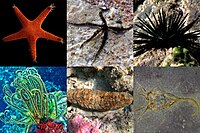
Photo from wikipedia
The innate immune system is the first line of defense protecting the hosts against invading pathogens. Mud crab (Scylla paramamosain) is widely distributed in China and Indo-west Pacific countries, which… Click to show full abstract
The innate immune system is the first line of defense protecting the hosts against invading pathogens. Mud crab (Scylla paramamosain) is widely distributed in China and Indo-west Pacific countries, which develops a very complicated innate immune system against pathogen invasions. Innate immunity involves the humoral and cellular responses that are linked to the pattern recognition receptors (PRRs). PRRs initially recognize the infection and trigger the activation of signaling cascades, leading to transcriptional regulation of inflammatory mediators that function in pathogenic control and clearance. In mud crab S. paramamosain, the Toll/Toll-like receptors, lipopolysaccharide and β-1,3-glucan binding proteins, C-type lectins, scavenger receptors, and down syndrome cell adhesion molecules have been identified as receptor families responsible for the recognition of bacteria, fungi, and viruses, and are important components in the innate immune system. In this review, we summarize the literature on the current knowledge and the roles of PRRs in the immune defenses of mud crab, which in an effort to provide much information for further researches.
Journal Title: Developmental and comparative immunology
Year Published: 2019
Link to full text (if available)
Share on Social Media: Sign Up to like & get
recommendations!